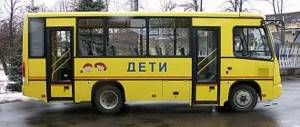Good afternoon, dear reader.
This article will discuss the rules for transporting groups of children on a bus . Over the past few years, several regulations related to this issue have been issued and amended. All of them were reviewed on pddmaster.ru.
This article contains generalized information and will be updated as legislation changes.
Please note that issues of organized transportation of children affect not only transport companies.
For example, if parents of schoolchildren want to organize an excursion for their children, then they will also have to comply with the transportation rules.
This article will discuss the documents required for transportation, requirements for buses and the people on them.
- traffic police document;
What is organized transportation of children?
Clause 1.2 of the traffic rules:
“Organized transportation of a group of children” - transportation on a bus that is not a route vehicle, a group of children of 8 or more people, carried out without their parents or other legal representatives.
Please note that organized transportation does not include:
- Children's ride on a minibus. For example, if children and their teacher go to the theater on trolleybus number 1.
- Transportation of 7 or less children.
- Transportation of 8 or more children and several parents, in which 7 or less children are traveling without parents.
Organized transportation includes transportation when:
- People travel on a bus that is not a route vehicle.
- Among the people there are at least 8 children whose parents are not present on the bus.
If the above conditions are met, then you should read this article to the end and study the transportation rules.
What do the rules for transporting children by bus at night provide?
Part of the Rules approved by Decree of the Government of Russia dated December 17, 2013 No. 1177 (as amended on April 28, 2020) provides for the rules for transporting children by bus at night.
According to these Rules, at night, that is, from 11 pm to 6 am, the following are allowed:
- organized transportation of groups of children to train stations, airports (as well as from them);
- completion of the procedure for the appropriate organized transportation (for example, if it is necessary to deliver children to the hotel) in the event of an unplanned disruption to the schedule if there is a delay on the road;
- organized transportation carried out in accordance with the orders of the highest executive bodies in the constituent entity of the Russian Federation.
At the same time, the distance of transportation started after 11 pm should not be more than 100 km.
Any standards prescribed in Resolution No. 1177 apply to organized groups of children of 8 or more people, without parents and with accompanying persons, transported in a non-route (registered) bus. If fewer children are transported or if they are traveling on a regular bus, then the above restrictions may not be observed.
Apart from the relevant restrictions, transportation of children at night is organized according to the same rules as during the day. Let us consider them further in the context of the fulfillment by the organizers of the transportation (school, education department) of certain responsibilities for preparing the trip.
Participants of organized transportation
Currently, the list of persons who can participate in organized transportation is strictly limited. Clause 14 of the rules for transporting children by bus:
14. If a child or other person included in the list fails to appear, information about him or her is deleted from the list. In addition to the driver (drivers), other persons other than those indicated in the lists are not allowed on the bus. Monitoring compliance with these requirements is the responsibility of accompanying persons.
Only :
- driver(s);
- children included in the passenger list;
- accompanying persons included in the list of passengers;
- a medical worker included in the passenger list.
Please note that the legality of each person on the bus must be confirmed by an appropriate document. You cannot take a person on a trip without a document.
As an example, consider the following situation. The 11th grade of a secondary school is going on a tourist trip. At the same time, some students have reached the age of 18, i.e. they are not children. The rest of the class remains children. How to prepare documents in this case?
It's actually quite simple:
- Students under 18 years of age must be listed as children on the passenger list;
- Students over 18 years of age must be included on the passenger list as accompanying passengers.
Let's take a closer look at each of the trip participants.
Bus driver
The driver must meet the following requirements:
- working as a category D driver for 1 year out of the last 2 years (until January 1, 2021 - 12 out of the last 13 months);
- undergo pre-trip briefing;
- absence of punishment in the form of deprivation of rights or administrative arrest during the last year.
Children
Children under 18 years of age must be included as children on the passenger list.
Moreover, if there is at least one child under 7 years of age on the list, then the bus schedule must be drawn up so that the bus does not travel longer than 4 hours. That is, we are talking about the total duration of the trip. So it won’t be possible to take small children on long trips.
Accompanying
All accompanying persons must be included in the passenger list as accompanying persons.
Accompanying persons are assigned to each of the buses involved in transportation. The minimum number of accompanying persons is 1 person at each bus door intended for boarding.
If the bus has 2 doors, then there must be at least two accompanying people.
Note. From 1 January 2021, only 1 accompanying person is allowed on the bus if the group includes 20 children or less. In this case, passengers board and disembark through one door of the bus, near which there is an accompanying person.
The maximum number of accompanying persons is not limited.
For example, 8 children and 30 accompanying persons can travel on a bus.
One of the accompanying persons on each bus is designated as responsible.
a senior responsible escort is also appointed . Until October 1, 2019, the senior person in charge could only travel on the last bus in the convoy. After October 1, this requirement is canceled and the senior accompanying person can ride on any bus.
Adult passengers
All adult passengers on the bus must be included on the passenger list as companions.
Medical worker
A medical professional is only required if the trip meets both the following conditions:
- the trip is intercity (until January 1, 2021);
- the duration of the scheduled trip exceeds 12 hours;
- there are 3 or more buses in a convoy (from January 1, 2021).
From October 1, 2021, a medical worker can travel on any bus in the convoy. Previously, he was supposed to be on the last bus.
Transportation of organized groups of children by bus. Questions - answers
Home / Travel for children's groups by transport / Organization of transportation of groups of children by road / Rules for transportation of groups of children by bus. Questions and answers
Updated February 8, 2021
The published material on the transportation of organized groups of children by road has been prepared on the basis of the following legislative acts:
- Decree of the Government of the Russian Federation of September 23, 2020 N 1527 “On approval of the Rules for the organized transportation of a group of children by buses.” Effective January 1, 2021 and valid until January 1, 2027.
- Decree of the Government of the Russian Federation No. 1177 of December 17, 2013 was adopted “On approval of the Rules for the organized transportation of a group of children by buses.” This resolution is subject to cancellation as part of the implementation of the “regulatory guillotine” mechanism.
- Decrees of the Government of the Russian Federation regarding the Rules for the organized transportation of a group of children by buses dated June 23, 2014, June 30, 2015 (Decree No. 652), June 22, 2021 (Decree No. 569)
- Federal Law No. 138-FZ of May 1, 2021 “On Amendments to the Code of the Russian Federation on Administrative Offences” (on administrative fines for violating the Rules for the organized transportation of a group of children)
! If new regulatory and other documents appear, they will be reflected in this text.
One of the most pressing problems in transporting children was the age limit of the bus (with a service life of up to 10 years.) Since this requirement was impossible to implement with the existing fleet of buses in the country for transporting groups of children, this paragraph of Resolution No. 1177 was postponed 8 times . In 2021, the Government decided to resolve this issue and issued a new Decree, which made adjustments to the Rules for transporting groups of children by bus, for which both users and carriers had been fighting for several years. HOORAY!
Changes that come into force in 2021 will be marked in red in the text.
Let's start by defining what “ORGANIZED TRANSPORTATION OF A GROUP OF CHILDREN” is.
Are there age restrictions for transported children?
Yes, I have.
The inclusion of children under 7 years of age in a group of children for organized transportation by bus when they are on the route for more than 4 hours is not allowed.
Are there any time restrictions for transporting children?
Yes, I have.
It is not allowed to transport children at night from 23:00 to 6:00.
* Transportation of groups of children “at night (from 11 p.m. to 6 a.m.) is allowed to and from railway stations, airports, completion of the organized transportation of a group of children (delivery to the final destination determined by the schedule, or to an overnight stay) in case of an unplanned deviation from the traffic schedule (if there is a delay in transit), as well as organized transportation of a group of children, carried out on the basis of legal acts of the highest executive bodies of state power of the constituent entities of the Russian Federation . Moreover, after 11 p.m., the transportation distance should not exceed 100 kilometers.” .
What documents are required to transport a group of children?
- Vehicle charter agreement,
- a copy of the traffic police notice,
- a correctly formatted group list,
- trip program
- route sheet indicating travel times, sanitary stops and places to eat along the route.
- a completed boarding document indicating the actual seats of each child on the bus.
Who can the traffic police fine and for what and what is the size of the fine for violating the Rules for transporting a group of children by bus?
For violations of the Rules for transporting an organized group of children by bus, the traffic police may fine both the driver, the carrier and the trip organizer. The fines are quite large.
Who can be on a bus with an organized group of children?
clause 13
The organizer of the organized transportation of a group of children includes in the list, in addition to the driver (drivers), persons who are allowed to be on the bus:
- children, indicating the last name, first name, patronymic (if any), date of birth of each child, as well as contact telephone numbers of his parents (legal representatives);
— accompanying persons indicating their last name, first name, patronymic and contact telephone number;
— a medical worker indicating his last name, first name, patronymic and contact telephone number;
For example, parents of children should not be allowed on the bus if they are not included in the preliminary list. Everyone on the bus must be included in the list.
If one of the persons declared on the list is missing, then information about him is deleted from the list.
If an adjustment is made to the list, the change is certified by the person responsible for the organized transportation of a group of children.
When is a medical professional needed to accompany children when traveling on a bus?
clause 11
If the duration of an organized trip for a group of children exceeds 12 hours and 3 or more buses are used for its implementation, then the organizer ensures that the children are accompanied by a medical professional.
Who is the organizer of the organized transportation of a group of children?
This is a legal or natural person who organizes a trip for children - a travel agency, sports society, school, parents, etc. - and is the customer of the vehicle.
How many accompanying persons should there be when transporting children by bus?
(clauses 8,9)
The head or official responsible for ensuring road safety of the organization, and in the case of organized transportation of a group of children under a charter agreement, the charterer ensures that each bus carrying children is assigned an accompanying person who accompanies the children during transportation to their destination.
The minimum number of accompanying persons per group of 20 children or more is determined based on their presence at each door of the bus, while one of the accompanying persons is responsible for the organized transportation of a group of children on the corresponding bus and coordinates the actions of the driver (drivers) and other accompanying persons on the specified bus.
This is the minimum number of accompanying persons, but in fact there may be more of them on the bus.
When are dry rations needed?
Resolution No. 1527 says nothing about dry rations.
Who must notify the traffic police about the trip and when is it necessary to escort buses with traffic police vehicles?
(clauses 3,4,5,6)
When organizing transportation of a group of children by 1 or 2 buses under a charter agreement, the charterer (trip organizer) or the charterer (by mutual agreement) submits a notification to the traffic police department of the territorial body of the Ministry of Internal Affairs at the district level at the place where the organized trip of the group of children begins no later than 48 hours before the start of transportation in intercity traffic and no later than 24 hours before the start of transportation in urban and suburban traffic.
The notice may be submitted electronically.
If a group of children travels on 3 or more buses, then an application is submitted for the buses to be escorted by a patrol car (vehicles) of the State Traffic Inspectorate unit.
What to do if there is an unexpected delay on the way?
In such cases, when due to unforeseen circumstances the traffic schedule changes, the travel time changes due to changes in road conditions (traffic restrictions, the appearance of temporary obstacles, etc.), the manager or official responsible from the organization for children, the charterer or the charterer (by mutual agreement) ensures that measures are taken to promptly notify parents (legal representatives) of children, and, if necessary, the traffic police department.
What to do if the bus breaks down on the route or the driver is replaced?
In such cases, you must report this to the traffic police officer on duty. Before your trip, check the phone number on the traffic police website (if you submitted a notification)
If the technical fault cannot be resolved on site, the trip organizer or driver contacts the charterer to replace the bus.
What kind of transport is used to transport an organized group of children?
A yellow or orange beacon must be on or above the bus roof.
The bus must be equipped with seat belts. Children must wear seat belts while driving.
Restrictions on buses manufactured over 10 years have been lifted until 2027. Transport must be in technically sound condition.
What are the requirements for the driver?
paragraph 17
Drivers who meet the following requirements are allowed to drive buses carrying out organized transportation of groups of children:
- having worked as a driver of a category “D” vehicle for at least one year as a driver within the last 2 years;
- who were not brought to administrative liability in the form of deprivation of the right to drive a vehicle or administrative arrest in the field of road traffic within a year before the start of organized transportation of groups of children;
- who have undergone pre-trip instruction on the safety of transporting children in accordance with the Rules for ensuring the safety of transportation of passengers and cargo by road transport and urban ground electric transport, approved by the Ministry of Transport of the Russian Federation;
- have undergone a pre-trip medical examination in the manner established by the Ministry of Health of the Russian Federation.
_______________________________________________________________________________________
ADDITIONALLY
While driving, especially in intercity traffic, children must fasten their seat belts, do not walk around the bus interior, do not sit on the handrails of the seats; meals for children are provided only during stops. All these measures will protect children from injuries and accidents during sudden/unexpected braking of the bus.
It is difficult for children to remain motionless for long periods of time. In this case, provide stops along the way at parking lots along the route. Do not sit on the bus waiting for children at scheduled and unscheduled stops, get off the bus with them and ensure that they get off the bus and board from each door of the bus.
Follow the requirements for transporting organized groups of children and the formalities for registering children's travel by road!!
Documents for organized transportation
Traffic police document
If transportation is carried out by one or two buses, then a copy of the traffic police notification .
Submitting a notification to the traffic police
If the transportation involves 3 or more buses, then a copy of the traffic police decision on assigning an escort or refusing to provide an escort is required. In case of a positive decision on the application, the convoy of buses is accompanied by one or more police vehicles.
List of all passengers
From October 1, 2021, all passengers can be included in a single list , that is, issuing separate lists for children, accompanying and adult passengers is not required.
For example, the list might look like this:
| Full Name | Additional Information | |
| child | Ivanov Ivan Ivanovich | Age: 12 years. Parents' phone number |
| accompanying | Petrov Petr Petrovich | Telephone |
| accompanying | Volkov Arkady Dmitrievich | Telephone |
When filling out information about children, instead of the “Age” column, the “Date of Birth” column can be used.
Note. If a medical professional is involved in the trip, he must also be included in the passenger list. In addition, a license to carry out medical activities or an agreement with a medical organization must be attached.
Driver's document
Attention! From January 1, 2021, an additional driver document is no longer required .
The driver's document must indicate his full name and telephone number. If there are several drivers, then the document indicates the details of each of them.
Please note that we are not talking about a driver's license. A separate document is required, which must be prepared by the transportation organizer.
In addition, you don’t have to issue if the documents include a copy of the traffic police notification about the transportation. Such notification is mandatory if the transportation involves 1 or 2 buses.
Procedure for boarding passengers on the bus
Attention! From January 1, 2021, passenger boarding procedures are no longer required .
The order of boarding passengers includes information about how exactly it is controlled that exactly the passengers from the list got on the bus:
- according to documents (official ID, travel voucher, student card);
- according to the list of passengers;
Transportation route
Transportation route information must include:
- point of departure;
- intermediate pick-up/drop-off points;
- destination;
- stopping places for food and rest.
Note. Before October 1, 2021, a traffic schedule was also required, which should have indicated the time of arrival at different points along the route.
Additional documents
Documents that the driver must have only in some cases:
- The charter agreement or a copy thereof (if such an agreement was concluded).
- List of a set of food products if children are traveling for more than 3 hours (until January 1, 2021).
Please note that the originals of all the documents listed above must be kept for 90 days from the date of the trip , and if an accident involving victims occurred during the trip, then for 3 years.
Documentation requirements
- Now you need to submit a notification to the State Traffic Inspectorate at least 24 hours before departure for urban and suburban trips, at least 48 hours for intercity trips.
- If the driver was given a copy of the notification to the State Traffic Inspectorate, which contains information about him, then an additional document need not be drawn up.
- When submitting a notification to the traffic police, a name list of passengers (children and accompanying persons) is no longer required, but only their number. The passenger list must be given to the driver before the start of the trip.
- During the trip, all documents must be with the driver. It is he who will present them during inspection.
- It is no longer necessary to take the original charter agreement with you on your trip. You can limit yourself to a copy of it.
- Now the procedure for boarding the bus is approved not only for children, but also for other passengers.
- In the lists of passengers, it is necessary to note the pick-up and drop-off points for each person (both children and adults), if they do not coincide with the starting and ending points of the trip.
- According to the new rules, the list of passengers can be one (general) or several (separate children, separate accompanying persons, etc.). Previously, each list had to be prepared separately.
- If by the time of departure someone from the list has not appeared, they are simply crossed off.
- In the list of children it is now allowed to indicate not age, but date of birth. This simplifies the preparation of documents for groups that travel with the same composition (school classes, sports sections, etc.).
- The route program is no longer needed; a transportation route is required instead. The transportation route must indicate: points of departure and arrival, intermediate stops for boarding/disembarking passengers, and for multi-day trips - stops for meals and rest, including overnight. There is no longer any need to indicate the approximate stop time; it is enough to indicate the main points through which the bus will travel.
- Restrictions on the time limits for transferring documents between travel participants no longer apply. It is important to give documents to the driver and the senior person responsible for the trip before departure.
- Documents should be kept at the end of the trip for 3 years if an accident occurred during the trip in which there was at least one casualty (this means not only injured passengers, but also any others), and 90 days in other cases.
Bus for organized transportation
Paragraph 22.6 of the traffic rules:
22.6. Organized transportation of a group of children must be carried out in accordance with these Rules, as well as the rules approved by the Government of the Russian Federation, on a bus marked with identification marks “Transportation of Children”.
requirements apply to the bus :
- Installation of a sign “Transportation of children”. The sign is installed in front and behind the bus.
- Turn on a yellow or orange beacon (starting from July 1, 2021).
- The bus must be equipped with seat belts (from October 1, 2021).
In addition, a bus for the organized transportation of children must meet the requirements for all buses for the transportation of passengers:
- The bus must comply in terms of purpose and design with the technical requirements for the transportation of passengers.
- The bus must be permitted to participate in road traffic.
- Installation of tachograph.
- Installation of GLONASS or GLONASS/GPS satellite navigation equipment (not valid from March 19 to May 31, 2021).
Buses for transporting children and technical requirements GOST R 51160-98
The requirements for a bus permitted to transport minor children are established by the standard.
Previously, GOST R 51160-98 was in force in this regard, but from July 1, 2017, GOST 33552-2015 came into force instead.
Its scope applies to all vehicles for transporting passengers under 16 years of age, for their maximum safety.
According to the requirements of this standard, the bus must:
- be equipped with a speed limiting device if its design allows the speed to exceed 60 km/h;
- have yellow coloring, identification marks indicating the transportation of children, and also have inscriptions on the sides in large contrasting letters “Children”;
- be equipped with an automatic warning system when reversing;
- undergo periodic inspections and maintenance of all mechanisms and parts responsible for safe operation.
The document also establishes the rules for the arrangement of seats in the cabin, the equipment of the driver's workplace, and the requirement for restraint systems.
Requirements for group transportation of children are also imposed by the rules approved by Resolution No. 1527. According to it, such a bus must:
- meet the technical requirements for passenger transportation;
- be allowed to travel on roads;
- be equipped with a tachograph and a GLONASS or GLONASS/GPS navigation system;
- equipped with seat belts.
How to transport children by car in 2021?








